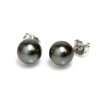It is thanks to the Margaritifera oysters of Pinctada that have black lips that we have these beautiful black pearls of Tahiti. But we notice that they are not only black and that they also offer us a beautiful color palette.
Are Tahitian pearls mainly black and grey ?
It is thanks to the oyster from which it originates that the pearls are black. Indeed, the oyster secretes a dark pigment, close to black. Thus, during the two years of creation necessary for an oyster to form a pearl, it will gorge itself with this pigment to become a jewel of the Polynesian islands. Tahitian pearls are unique thanks to their famous "black" colors, but in reality the color palette of these pearls is much larger than we think. There are some shades of grey, silver, smoky black as charcoal, and plenty of other shades with green. It is therefore inferred that black Tahitian pearls are actually extremely rare. Grey Tahitian pearls, on the other hand, are much easier to find. Pearl farming was so new at the time that graft cutouts limited the beads to grey and black colours. Now, each of the pearls found with all these color palettes(green, brown, silver gray, blue, purple)gives a unique look to Tahitian pearls.
Why all these colors?
With the advancement of research in pearl farming, the pearl growers wanted to cultivate the pearly color palette given by the shells of the young oysters Margaritifera de Pinctada. The grafters have cut out part of the so-called oyster mantle to lead to the production of beads of different colors. Depending on where the cut was made, the beads may have beautiful shades of different colors while remaining very dark.

Are they natural?
All these pearls are of course natural. But you still have to be careful of the imitations. Indeed, some sellers do not hesitate to rip people off by dyeing freshwater pearls and making them look like Tahitian pearls. Tahitian pearls are not necessarily round. You can find them slightly oval, in the shape of a button, a drop, with a baroque style or even a type of circled.
Conclusion
To conclude, the tahitian pearl is black thanks to the pigment that secretes the oyster from which it originated. This absolute black is very rare, because often the beads are nuanced with a fairly wide range of colors, ranging from blue to green, through gold and silver. Of course, it is possible to have other pearl colors, but only by intervening on its production. To do this, the grafters cut a small piece of the oyster's mantle. All these pearls are of course natural, but there are imitations using stained freshwater cultured pearls to give them the name of Tahitian Pearls.


















